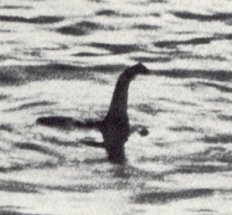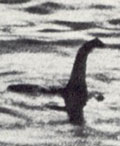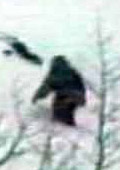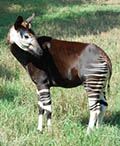Preparations for Chinese New Year
Preparations for Chinese New Year festivities in Indonesia begin well in advance of the actual date. As the year draws to a close, ethnic-Chinese tie up loose ends and put things in order in anticipation of beginning the New Year with a fresh start and a clean slate. Businesspeople balance their books and collect or pay debts that are owed.
Those who cannot afford to pay off their debts spend the pre-New Year season evading  creditors, hiding in temples or hidden in their homes. In ancient China, debt collectors would seek out debtors using a lantern up until the midnight hour. It is considered vulgar to mention debts on Chinese New Year's so these matters have to be settled prior to the holiday. If unfinished business can be resolved before the coming of the New Year, then one is left with a bright and optimistic start for the coming year.
creditors, hiding in temples or hidden in their homes. In ancient China, debt collectors would seek out debtors using a lantern up until the midnight hour. It is considered vulgar to mention debts on Chinese New Year's so these matters have to be settled prior to the holiday. If unfinished business can be resolved before the coming of the New Year, then one is left with a bright and optimistic start for the coming year.
An important part of the preparations for the holiday is the thorough cleaning of the family home. This is important not only as preparation for the many guests who are expected during the holidays, but also because it is symbolic of sweeping away the evil sprits that might be lurking in dark corners or behind heavy pieces of furniture that are rarely moved. The windows are washed and repainting is done and in traditional homes they would paint the window frames and doors red to prevent evil sprits from entering and to bring good fortune to the inhabitants.
might be lurking in dark corners or behind heavy pieces of furniture that are rarely moved. The windows are washed and repainting is done and in traditional homes they would paint the window frames and doors red to prevent evil sprits from entering and to bring good fortune to the inhabitants.
All cleaning and sweeping must be completed before New Year's Day, with the brooms and brushes out of the house prior to the dawn of the New Year. Otherwise the family believes they will have bad luck and a year of work and drudgery. Sweeping can not be done on New Year's Day for fear that good fortune would be swept away.
In some very superstitious families it is believed that sweeping is allowed on the second day of the New Year, however the sweeping of the dust must be done towards the center of the room. Then, the collected dust must be put into the corners of the room and not taken or thrown out until the fifth day of the New Year when it can be thrown away via the back door. If the dirt is discarded in this way, no harm will befall the family. At no time should this dust be trampled on, as it will cause bad luck. It is thought that if you sweep dirt over the threshold you will also sweep one of the family members away.

Shopping is a major part of the pre-celebration preparations. Historically, New Year's Day was one of a few days in the year when the hard working Chinese peasants allowed themselves a day of rest. Since it was everybody's day of rest, including the shop owners, all shopping had to be done prior to New Year's Eve. In Indonesia, most shop owners observe the Chinese New Year by closing their shop for 3 or 5 days. The normally vibrant Chinese business districts in cities across Indonesia become quiet, with shuttered shops the norm. Shop owners would never close for 4 days as this number, when verbalized, sounds like the Chinese word for death, therefore bringing their business bad luck.
Gift Giving
It is common to exchange gifts during the holiday season, so many ethnic-Chinese go on a buying frenzy in preparation for the gift exchange. The gift and its value depend on the social status of the giver and the receiver. Costly or exotic foods or a specially prepared food that has some symbolic meaning are common gifts.
Flowers are also considered an auspicious gift, as they brighten the house of the recipient. The Chinese know that without flowers there would be no formation of fruit, so it is very important to have flowers and floral decorations in the home during the holiday season. Flowers are thought to be the emblems of the reawakening of nature, and are intimately connected with superstitions and with the wish for happiness during the ensuing year. Blooming plants are also a symbol of rebirth and new growth. Small tangerine or orange trees symbolizing abundant happiness, and white Jonquils or Narchssus are favorite gifts within the Chinese community in Indonesia.
 Paper decorations are also bought and used to decorate the house. Pictures of ripe fruit or healthy smiling babies are common. Banners with gold Chinese lettering on bright red backgrounds are sold. These banners would be pasted on either side of the front entrance to Chinese homes with another banner above the door. The writing on the banners expresses wishes for good fortune, long life and many friends. Classically they would be poetic in composition. Some examples of common poems are: 'May you enjoy continuous good health' or 'May the Star of Wealth, Star of Longevity, and Star of Happiness shine upon you'.
Paper decorations are also bought and used to decorate the house. Pictures of ripe fruit or healthy smiling babies are common. Banners with gold Chinese lettering on bright red backgrounds are sold. These banners would be pasted on either side of the front entrance to Chinese homes with another banner above the door. The writing on the banners expresses wishes for good fortune, long life and many friends. Classically they would be poetic in composition. Some examples of common poems are: 'May you enjoy continuous good health' or 'May the Star of Wealth, Star of Longevity, and Star of Happiness shine upon you'.
Chinese New Year's cards are sent to family members who live far away and are unable to join the traditional family gathering. The cards are predominantly red with images of the upcoming year's animal zodiac sign, gold coins or money, cherry blossoms, r fish, all of which are objects that represent good luck and fortune.
join the traditional family gathering. The cards are predominantly red with images of the upcoming year's animal zodiac sign, gold coins or money, cherry blossoms, r fish, all of which are objects that represent good luck and fortune.
According to tradition, families should wear new clothing during the festivities. Chinese believe that the appearance and attitude of a person on New Year's Day sets the tone for the coming year. People often choose to wear red clothing, a bright and happy color that will ensure the wearer a bright future.
New Year's Eve
On New Year's Eve family members gather to observe the customs and share a traditional meal. Family members come from across town or across the Indonesian archipelago to welcome in the New Year together, usually at the home of the eldest family member.
According to custom, the male head of the family leads the family in making offerings to various house gods and family ancestors. Respect is paid to the god of wealth and the gods of the well, bed, hearth and other gods who the family wants to remain on good terms with. The offerings are usually a variety of foods, cakes and fruits placed on an offering table, placed outside the house. While holding the incense in both hands, each family member would 'pai-pai' (bow down) three times to show respect and honor for the house gods. Then the incense is placed in a holder on the offering table and family members bow again to show respect and ask permission to enter the house.
An offering table or ancestral table is also set up inside the house, if there is a member of  the family who has already passed away. A picture of the deceased is hung above the table. In wealthier family's homes an entire room might be used as an ancestral hall complete with altar and tables for each generation. Small offerings are placed throughout the year to honor deceased family members. On New Year's Day, however, the table overflows with a beautiful display of food, flowers and the special dishes once enjoyed by the deceased during his/her life.
the family who has already passed away. A picture of the deceased is hung above the table. In wealthier family's homes an entire room might be used as an ancestral hall complete with altar and tables for each generation. Small offerings are placed throughout the year to honor deceased family members. On New Year's Day, however, the table overflows with a beautiful display of food, flowers and the special dishes once enjoyed by the deceased during his/her life.
Family members are expected to show respect to their ancestors by lighting incense and bowing in front of the offering table. It is even more respectful if one kneels down in front of the table. Only after respect has been paid to the ancestors can you continue with the evening's festivities. Chinese around the world believe that the spirits of the loved ones are in attendance during the evening's celebrations. When ancestor worship rites are complete, the family gathers for the biggest meal of the year.
Significance of Traditional Foods
More food is consumed by Indonesian Chinese families during the New Year celebration than at any other holiday. As it is considered bad luck to cook on New Year's Day itself, food is prepared the day before. Chinese believe that what you do on New Year's Day will reflect on your life in the coming year, so most housewives do not want to take a chance of being 'chained to the oven'. The large number of traditional dishes prepared is also meant to symbolize abundance and wealth for the household.
Most traditional dishes served on Chinese New Year are chosen for the significance of their name or appearance. One required dish is a whole fish. Fish in Chinese is 'yu' which sounds similar to the word meaning surplus or abundance. A whole fish must be served as this represents family togetherness. Oysters are also a favorite. In Cantonese the word oyster sounds like the word that means 'good business.' In Cantonese shrimp is pronounced 'ha', which to the Chinese sounds like laughter so it also often included. Clams are another favorite, as they open up when cooked, symbolizing the opening of new horizons.
Indonesian Chinese whose ancestors come from Shanghai serve egg skin dumplings which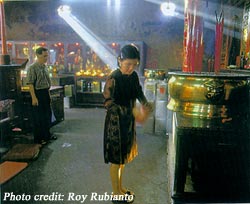 are thought to look like gold ingots and glass noodles are thought to resemble silver chains, which earn them a place at the festive meal. Bean sprouts are another favorite. They are said to resemble a traditional scepter-like art object called 'ruyi', which means 'to your heart's content', symbolizing a great way to start a New Year. The word for black moss seaweed sounds similar to the word for 'exceeding in wealth'. Lotus seeds are believed to signify having many male offspring, which is much desired in a Chinese family. Chicken is considered a symbol of prosperity. The chicken however, should be presented with the head, tail and feet to symbolize completeness. Noodles are also considered a necessity but should be uncut as in this state they represent long life.
are thought to look like gold ingots and glass noodles are thought to resemble silver chains, which earn them a place at the festive meal. Bean sprouts are another favorite. They are said to resemble a traditional scepter-like art object called 'ruyi', which means 'to your heart's content', symbolizing a great way to start a New Year. The word for black moss seaweed sounds similar to the word for 'exceeding in wealth'. Lotus seeds are believed to signify having many male offspring, which is much desired in a Chinese family. Chicken is considered a symbol of prosperity. The chicken however, should be presented with the head, tail and feet to symbolize completeness. Noodles are also considered a necessity but should be uncut as in this state they represent long life.
Ethnic-Chinese who have immigrated to Indonesian from the northern part of China serve 'jiaozi' or meat-filled dumplings. The pronunciation of this word sounds like a word meaning 'meeting of the last hour of the old year with the first hour of the new'. In the southern regions of China, 'nian gao' is an important part of the festivities. Indonesian Chinese from these regions serve this sweet rice pudding for their New Year's festivities. Another popular delicacy is 'Zong zi', glutinous rice wrapped up in reed leaves. Some celebrants place stalks of sugar cane behind their doors, as the height and section-upon-section construction of the sweet stalks represents the family's hope for a ladder-like ascent to new levels of glory in the coming year.
A candy tray is considered a necessity on the coffee table of any Chinese home, for visiting family members and expected guests. The tray should be circular or octagonal in shape  and is called the 'Tray of Togetherness', symbolizing the family's sweet start of the New Year. Items on the tray are intentionally chosen for symbolic good fortune. Candied melon is symbolic of growth and good health. Melon seeds are dyed red to symbolize joy, happiness, truth and sincerity. Lychee nuts are thought to ensure strong family relationships. Kumquat represents prosperity while coconut symbolizes togetherness. Peanuts are thought to represent long life. Longan are believed to bring many good sons and lotus seeds many children. In very traditional families after taking several pieces of candy from the tray, adults place a red envelope containing money, ang pau, in the center of the tray to wish good fortune for the family.
and is called the 'Tray of Togetherness', symbolizing the family's sweet start of the New Year. Items on the tray are intentionally chosen for symbolic good fortune. Candied melon is symbolic of growth and good health. Melon seeds are dyed red to symbolize joy, happiness, truth and sincerity. Lychee nuts are thought to ensure strong family relationships. Kumquat represents prosperity while coconut symbolizes togetherness. Peanuts are thought to represent long life. Longan are believed to bring many good sons and lotus seeds many children. In very traditional families after taking several pieces of candy from the tray, adults place a red envelope containing money, ang pau, in the center of the tray to wish good fortune for the family.
Just as some foods are always served on New Year's Eve, there are other foods that are to be avoided for their perceived bad meanings. One of them is tofu. Chinese believe that white is the color of death and misfortune, so tofu is never included in the New Year's Eve meal as it might cause bad fortune to fall upon family members.
After Dinner Festivities
After dinner family members stay up late playing games, drinking wine, singing, joking and telling stories. Families strive to make the evening happy in hopes of setting the pattern for the incoming year. Mahjong and card games are popular ways to pass the time before midnight. According to superstitious belief, all the lights in the house must stay on throughout the evening. If the house is dark the god of good future will not be able to see it and will pass by.
Some families spend part of the evening going to the temple to light candles and pray to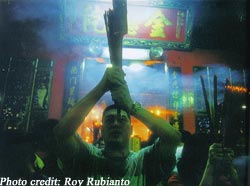 the gods such as Kwan Im, the goddess of love and mercy. In Indonesia, most of the temples hold midnight prayers. On Chinese New Year hundreds of candles burn in the temples, as adherents believe that candlelight symbolizes a bright future. Congregants donate huge candles, up to 6 feet tall and three feet in circumference, which will burn for several months. In the Jakarta area, these celebrations can be viewed at the oldest Chinese temple in Jakarta, Wihara Dharma Bhakti located on Petak Sembilan in the Kota district, Jakarta's Chinatown. Other temple celebrations can be viewed in Mangga Besar, Pluit as well as in the Boen Tek Nio Temple in Tangerang.
the gods such as Kwan Im, the goddess of love and mercy. In Indonesia, most of the temples hold midnight prayers. On Chinese New Year hundreds of candles burn in the temples, as adherents believe that candlelight symbolizes a bright future. Congregants donate huge candles, up to 6 feet tall and three feet in circumference, which will burn for several months. In the Jakarta area, these celebrations can be viewed at the oldest Chinese temple in Jakarta, Wihara Dharma Bhakti located on Petak Sembilan in the Kota district, Jakarta's Chinatown. Other temple celebrations can be viewed in Mangga Besar, Pluit as well as in the Boen Tek Nio Temple in Tangerang.
At midnight firecrackers are lit, not only to scare away Nian and other evil sprits, but also just to add to the excitement of the occasion. In traditional families every door and window in the house is opened to allow the old year to go out and good luck to come in with the New Year.
 as to what one's fortunes will be for the coming year. So, children pai-pai to their parents and wish them “Gong Xi Fa Cai” meaning 'Wishing you prosperity'. Parents give their children ang pao, a small red envelope containing money. Ang poa is also given to children of close relatives and unmarried family members after they have wished an elder Happy New Year. Once you are married you are considered to be a giver of ang poa and no longer receive it. It is unlucky to greet anyone in a bedroom so everyone, even the sick, should get dressed and sit in the living room.
as to what one's fortunes will be for the coming year. So, children pai-pai to their parents and wish them “Gong Xi Fa Cai” meaning 'Wishing you prosperity'. Parents give their children ang pao, a small red envelope containing money. Ang poa is also given to children of close relatives and unmarried family members after they have wished an elder Happy New Year. Once you are married you are considered to be a giver of ang poa and no longer receive it. It is unlucky to greet anyone in a bedroom so everyone, even the sick, should get dressed and sit in the living room. normally for the immediate family, on New Year's Day you should visit neighbors and distant relatives. According to tradition, people check on family and neighbors to make sure that the evil Nian monster had not eaten them. Superstition holds that women shouldn't go out to visit on the first day after New Year's because the household luck might go out with them. In some areas the second day is the day wives go to their parent's home, taking their children to see their grandparents. In Indonesia, the practice of visiting family and friends is more a sign of respect than due to belief in a monster. Most Chinese Indonesians spend the entire day driving around to visit family members; these visitations are a sign of respect that is highly valued in the Chinese community. If it is impossible to visit all the people that you want to see in one day, it is acceptable to visit any time during the next 15 days.
normally for the immediate family, on New Year's Day you should visit neighbors and distant relatives. According to tradition, people check on family and neighbors to make sure that the evil Nian monster had not eaten them. Superstition holds that women shouldn't go out to visit on the first day after New Year's because the household luck might go out with them. In some areas the second day is the day wives go to their parent's home, taking their children to see their grandparents. In Indonesia, the practice of visiting family and friends is more a sign of respect than due to belief in a monster. Most Chinese Indonesians spend the entire day driving around to visit family members; these visitations are a sign of respect that is highly valued in the Chinese community. If it is impossible to visit all the people that you want to see in one day, it is acceptable to visit any time during the next 15 days. means 'to advance in an upwardly fashion year by year'. So, Indonesian Chinese often serve 'kue lapis', an Indonesian layered cake, to their visiting guests. The layers of the cake symbolize the ladder to achievement during the coming year. Many Indonesian Chinese bring a gift of oranges or tangerines and enclose ang poa in the bag. Tangerines with leaves intact ensure that one's relationship with others will remain intact. For newlyweds this also represents the branching of the couple into a family with many children.
means 'to advance in an upwardly fashion year by year'. So, Indonesian Chinese often serve 'kue lapis', an Indonesian layered cake, to their visiting guests. The layers of the cake symbolize the ladder to achievement during the coming year. Many Indonesian Chinese bring a gift of oranges or tangerines and enclose ang poa in the bag. Tangerines with leaves intact ensure that one's relationship with others will remain intact. For newlyweds this also represents the branching of the couple into a family with many children. four dancers. The dancer that controls the head of the Barongsai must be well versed in Kung Fu as many of the steps in the dance resemble Kung Fu movements. Performers must have great strength and endurance when using the larger dragons as they can weigh up to several hundred kilograms.
four dancers. The dancer that controls the head of the Barongsai must be well versed in Kung Fu as many of the steps in the dance resemble Kung Fu movements. Performers must have great strength and endurance when using the larger dragons as they can weigh up to several hundred kilograms. night to help see the gods. In many parts of China today, the lanterns take on a variety of elaborate shapes and styles and are displayed in public exhibitions. The Lantern festival is another reason for inviting guests to your house for a large dinner. Although it is not on the same scale as the New Year's celebration, it is still considered an important meal. After dinner the men parade outside carrying colorful paper lanterns, which have slips of paper with riddles written on them hanging from the lanterns. Guests guess the answers to the riddles and a drum is sounded when the riddles are correctly answered.
night to help see the gods. In many parts of China today, the lanterns take on a variety of elaborate shapes and styles and are displayed in public exhibitions. The Lantern festival is another reason for inviting guests to your house for a large dinner. Although it is not on the same scale as the New Year's celebration, it is still considered an important meal. After dinner the men parade outside carrying colorful paper lanterns, which have slips of paper with riddles written on them hanging from the lanterns. Guests guess the answers to the riddles and a drum is sounded when the riddles are correctly answered. Chinese New Year's celebrations in Indonesia, known locally as Imlek, incorporate customs, beliefs and practices brought to Indonesia by Chinese immigrants who still follow the practices handed down from their parents.
Chinese New Year's celebrations in Indonesia, known locally as Imlek, incorporate customs, beliefs and practices brought to Indonesia by Chinese immigrants who still follow the practices handed down from their parents. will end on the full moon 15 days later. It is also sometimes referred to as the Spring Festival or the “Beginning of Spring.” Although known as Chinese New Year the Lunar New Year is actually celebrated by others besides the Chinese.
will end on the full moon 15 days later. It is also sometimes referred to as the Spring Festival or the “Beginning of Spring.” Although known as Chinese New Year the Lunar New Year is actually celebrated by others besides the Chinese.